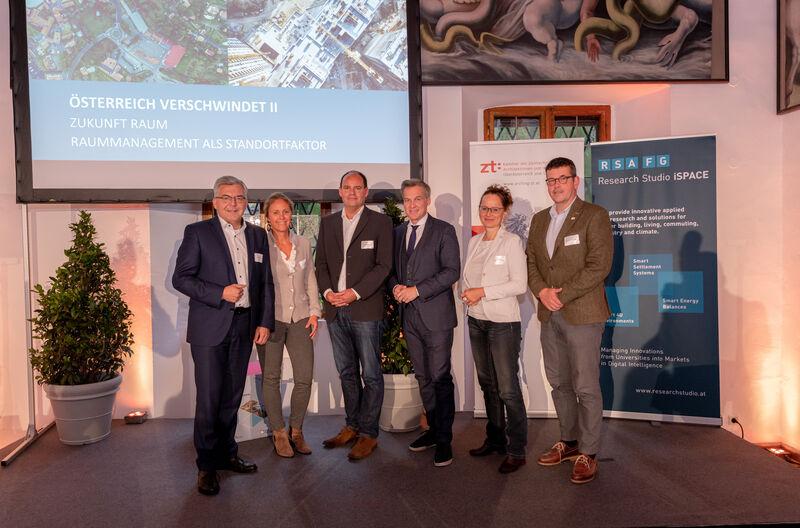Salzburg – More and more green meadows are falling victim to new buildings, and this despite the fact that we have just recognised the importance of green and open spaces during the Covid-pandemic. Is the increasing consumption of land unstoppable or are there solutions for new paths in spatial planning? These questions were addressed at the conference “Österreich verschwindet II”, organised by the Research Studios Austria FG and the Chamber of Civil Engineers Upper Austria-Salzburg, on 12 October at Hellbrunn Palace in Salzburg. Political representatives and scientific experts discussed strategies against land consumption.
Anyone who needs proof for how much soil is sealed every day in Austria, doesn’t usually have to look around for long: Construction sites on every corner, large untouched green spaces are visibly dwindling. On average, 11.5 hectares of unsealed soil are lost every day – and land consumption is no longer linked to population growth: since the turn of the millennium, land consumption has grown almost three times as fast as the Austrian population.
Even though Salzburg is a pioneer in “saving soil” with a comparatively low 0.1 hectares, there is still a lot to be done in this country. The sealing of soils not only reduces the green spaces that are important for recreation, but also poses a growing problem for the environment and climate. Ideas on how to deal with this were discussed at the conference “Österreich verschwindet II” in Salzburg on 12 October.
The list of speakers ranged from scientific experts to architects and political decision-makers. All agreed on one thing: the concreting over of more and more once green areas, the disappearance of natural spaces and the simultaneous lack of affordable, well-connected housing are a major problem.
ORF presenter Tarek Leitner, who hosted the event, pointed out in his opening speech that the detached single-family house with a garden is still considered the only ideal form of living in Austria. A goal that cannot be achieved for all 8.9 million Austrians: Sustainable spatial planning must use resources – including land – sparingly. At the same time, Leitner also posed the question: Where is there room for beauty? The beauty of the environment and architecture remains an original human need that must be taken into account in spatial and urban planning.

@Copyright Stadt Salzburg
Redensification instead of indefinite growth
Problembewusstsein und weitgehende Einigkeit in der Politik
In the first block of lectures, experts from geoinformatics and architecture presented constructional and technical solutions to deal with problems such as low land availability, high energy demand or challenges in public mobility. One such technical solution is the post-densification monitor, a project of Research Studios Austria FG and the City of Salzburg. Redensification – whether through the addition of more storeys to houses or the construction of extensions or additional residential buildings – offers an opportunity to create new living space without having to build immediately on “green fields”. The monitor makes it possible to calculate and visualise the potential for such redensification in cities. However, factors such as mobility, energy-efficient refurbishment and quality of life must also be taken into account – as the other presentations also showed.
The focus of the second half of the event was more on the political implementation of spatial planning. For example, Provincial Councillor Josef Schwaiger and Deputy Mayor Barbara Unterkofler of the Austrian People’s Party (ÖVP) presented Salzburg’s approach to rural and urban planning. Existing buildings are to be used more intensively and the redensification mentioned in the previous presentations is to be facilitated by regulation. Legal requirements are to enable the creation of living space in supermarkets, the conversion of attics, and the reduction of purchase and rental costs for young families.

@Copyright Stadt Salzburg
There was broad support for this in the subsequent panel discussion. The discussion with City Councillor Martina Berthold (The Greens), Mayor Tanja Kreer (SPÖ), as well as Deputy Mayor Unterkofler and Provincial Councillor Schwaiger, and on the expert side Prof. Ingrid Krau (TU Munich), Dr. Thomas Prinz (RSA FG, University of Salzburg), DI Max Mandl (Civil Engineer for Spatial Planning) and DI Dr. Andreas Schmidbaur (Spatial Planning City of Salzburg) met with lively interest among the participants. Current challenges were discussed as well as possible changes in mobility behaviour due to Corona and increasing home office regulations.
All participants agreed on the importance of resource-efficient spatial planning in Salzburg and beyond. However, Dr. Ingrid Krau, former professor of urban planning at the Technical University of Munich, also warned that caution should be exercised in post-densification. Especially in view of the Corona pandemic and several lockdowns, it has probably become clear to many how valuable green and open spaces are, even in cities. After all, beauty and quality of life are also factors that want to be taken into account in spatial planning.
You can find a recording of the event here.
You can find the photos of the event here.
All guests participated exclusively under a controlled 3G regime!

